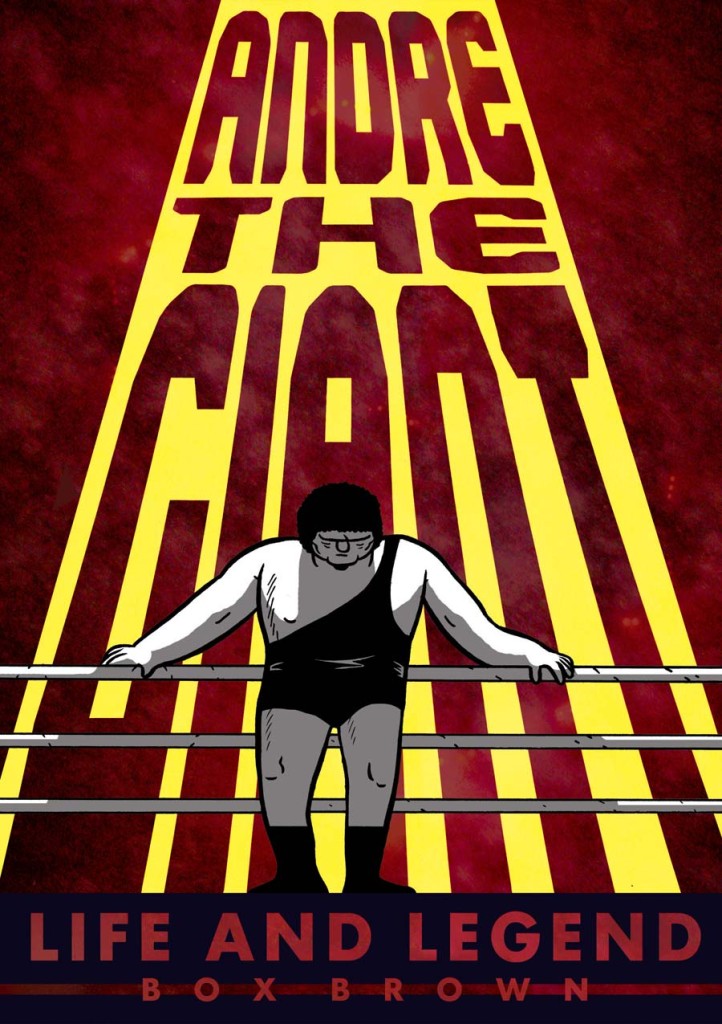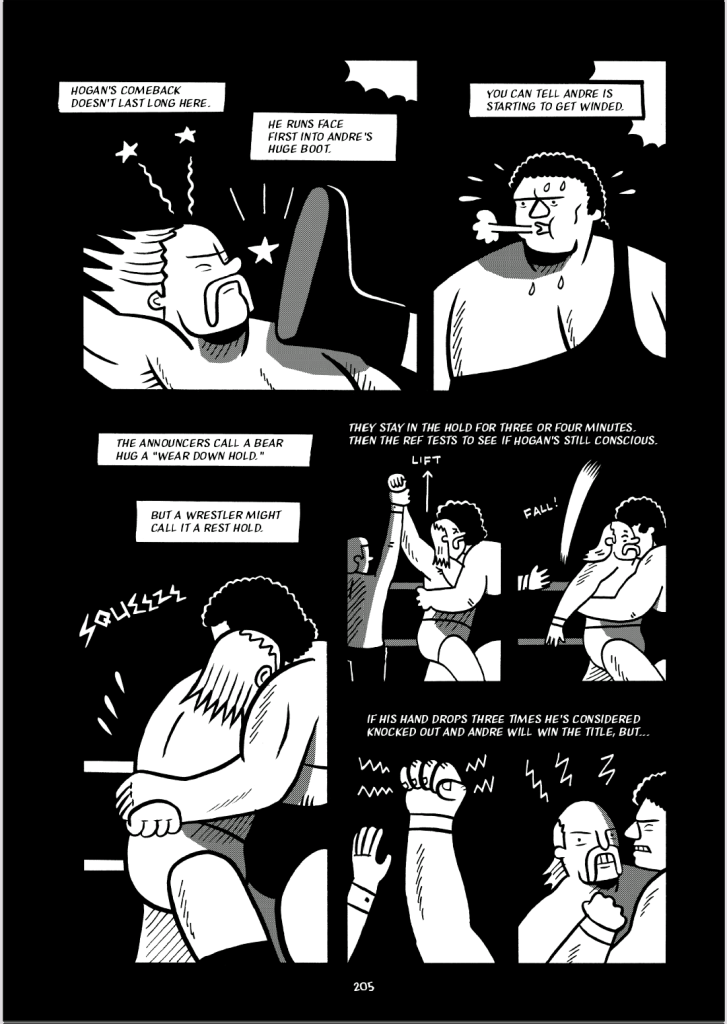One of the most tragic things about the life of Andre the Giant for me as a fan is how impossible it would be to make a film about such a unique individual. Who would you cast? There isn’t a person living who could capture the gait, the stature, the inimitable vastness of a man like Andre Roussimoff. You would end up needing to use forced perspective and camera tricks and make-up or CGI effects to get even close, and then we’re in “Peter Jackson remaking Ready 2 Rumble” territory, which is basically like a Bizarro World Flavor Country for wrestling fans.
In his new biography, graphic novelist Box Brown has proven again why comics are such a special medium, deftly blending words and images to tell the tall tale of Andre the Giant in a heartwarming way celluloid never could.
Andre Roussimoff was a farm boy from the French countryside who reached a height of 6’3″ by age twelve. By seventeen he found the world of professional wrestling, a spectacle practically made for a man of his stature, charisma, and heart. His size was a by-product of his struggle with gigantism, an ailment that caused his life to be one filled with constant physical pain. He was told he’d never make it past forty, a prognostication he outlasted by six years, living a life as epic in scope as his frame, and touching countless others in the process.
Brown’s book synthesizes a historical fiction narrative from interviews with wrestlers from the eras Andre worked through, as well as creating dramatized observations of important moments from his career. The story begins on the farm and takes you through to Andre’s final days, never wasting a moment or dwelling too long on one particular facet of his tale. The story functions both as a tribute to one of professional wrestling’s biggest icons and a primer on the inner workings of the sport, the latter serving as an ongoing FAQ style annotation to demystify the craft of wrestling so as to lay bare the world Andre inhabited.
Brown’s own forward explains that he wanted readers to have at the very least a rudimentary understanding of the industry, and he incorporates jargon in a natural way, using the gutters of the page as footnotes.
In two key scenes, he lays down a minute by minute breakdown of how an Andre the Giant match goes, sort of an anatomy of the scene style study. The first, early in the book, perfectly explains wrestling storytelling and Andre’s role within that framework by taking apart the basic kind of match he worked often in his career, and later, in the book’s climax, delves into the main event of Wrestlemania III with Hulk Hogan, a match singularly responsible for professional wrestling’s enduring place in mainstream culture.
What I love about this book above all else is how the “wrestling stuff” is there because it’s unavoidable; so much of Andre’s life took place inside a 20 x 20 ring, but these matters are presented with a sense of colloquial mundanity. If Andre had been the world’s tallest barber, Brown would have included smartly drawn vignettes of how the giant had to sit in a chair to cut his clients’ hair. The book exists to make you feel the kitchen sink drama of everyday life through the eyes of a man so much larger than it.
Andre’s life is big and bold enough for anyone to have made something at least passably readable from, but Box Brown’s distinctive line work, natural pacing, and clever storytelling make this biography a truly engrossing one. His black and white art is detailed just enough for likenesses to shine through and for spacial relationships between Andre and Everything That Is Not Andre to be clear, but his cartooning brings the material down to this really personal level that I had not anticipated. Other, perhaps lesser, authors might have gone out of their way to overdramatize some of Andre’s backstage dealings, but Brown employs a slow, steady, and assured hand to the proceedings. It’s as though the very flow of the page moves like Andre.
One of my favorite devices used in the book is a somewhat cinematic one, but it works so effectively on the page that I audibly cheered when I realized what was happening. Early in Andre’s career, he became over-saturated. Seeing a giant battle smaller men is astonishing at first, but see him every week and he becomes commonplace, a fixture in the background. It wasn’t until Vince McMahon, Sr., then owner of the WWWF (now WWE) got hold of him that he figured out the smartest way to book Andre was to have him tour the country so his arrival was a special occasion. To illustrate dwindling interest before this sea change, Brown juxtaposes a marquee advertising a sold out card with Andre battling Nikita Koloff (or possibly, Ivan, it’s unclear) against a later marquee with Andre challenging Rick Martel, tickets still available. The following page has subsequent panels depicting a series of sandwich boards with Andre versus various opponents accompanied by exponentially cheap concession deals.
There’s something simple in the way this grand story is told, but it is all the more affecting for it. Countless scenes of Andre drinking and celebrating with his colleagues have a conversational, laid back tone that perfectly captures Andre’s lovable persona. The dialogue has a dry, terse pitter patter that becomes hypnotic as the years pass. Andre speaks plainly, but his words often hint at deeper emotional complexity. He refers to everyone as deferentially as “boss” and he’s referred to the same way in return, with a sense of love and respect.
Though a majority of the book’s page count presents Andre as a cuddly folk hero whose temper only manifests against malicious jerks (like a fun scene when Andre flips a car over with two assholes inside who tried to pick a bar fight), later scenes show the more reckless, careless side of the giant, like him drunkenly calling Bad News Brown a racial slur or being absent from his estranged daughter’s life.
The structure of alternating between wrestling events and the marathon drinking sessions Andre and his comrades take part in feel celebratory and humorous at first, but curiously darken through their hollow repetition. A sense of unease and solemn sadness seeps in as Andre’s body begins to fail him and the sunset grows ever closer. Though it maintains a pedestrian pace, the book never fails to entertain; it’s roughly two hundred pages, wonderfully brisk, and hard to put down.
Andre The Giant: Life and Legend is a graphic novel worthy of the main it chooses to profile, full of heart and intrigue, sweetness and sadness, love and spectacle.
Andre The Giant: Life and Legend will be released Wednesday, May 7th from FirstSecond Books.




